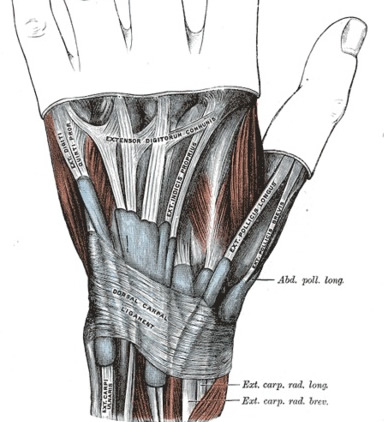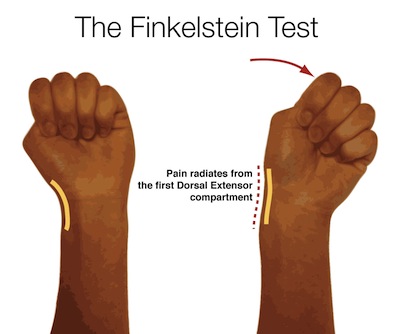
DeQuervain's Tenosynovitis
last authored: July 2011, David LaPierre
last reviewed: Feb 2012, Zaheer Kukkadi
Introduction
DeQuervain's tenosynovitis, also known as stenosing tenosynovitis, is one of the most common causes of radial wrist pain.

Hand and wrist flexors, from Gray's Anatomy
It is the result of inflammation of the tendons of the abductor pollicis longus and extensor pollicis brevis in the thumb, particularly under the retinacular pulley at the radial styloid.
The Case of Mary W
Mary W is a 28 year-old who became a mother 2 months ago. She comes to her doctor because her wrist has become extremely painful.
What causes deQuervain's tenosynovitis?
How would her doctor diagnose it?
How is it treated?
Causes and Risk Factors
DeQuervain's tenosynovitis is an overuse injury of the thumb tendons, following repetitive activities that irritate them. It is more common in middle-aged women.
Pathophysiology
Swelling or stenosis of the tendon sheath leads to symptoms. Inflammation thickens the sheath and reduces easy sliding. Triggering can also occur as the tendon appears to stick or lock.
Signs and Symptoms
- history
- physical exam
History
Patients report pain with movements that involve thumb abduction, flexion, and ulnar deviation, such as lifting babies or holding heavy frying pans.
Physical Exam
Swelling and tenderness is evident over the tendons near the distal radius, and crepitus may also be felt.

illustration by Katrina Moir
The Finkelstein test is very helpful in confirming diagnosis.
Enclose the thumb in the patient's palm and briskly ulnar deviate the wrist.
Pain should be felt radially.
Investigations
- lab investigations
- diagnostic imaging
Lab Investigations
There is no role for lab investigations.
Diagnostic Imaging
Although diagnosis is clinical, PA and lateral X-rays may be done to rule out abnormalities that could follow trauma.
Differential Diagnosis
The differential includes:
- carpometacarpal thumb arthritis (joint swelling and pain on compression)
- dorsal wrist ganglion (mass)
- flexor carpi radialis tendonitis
- scaphoid fracture (history of trauma, and tenderness over snuffbox)
- wrist arthritis (evidence on X ray)
Treatments
NSAIDs should be used for two weeks, if not contraindicated.
Modification of activities, avoiding aggravating movements, can help settle irritation and swelling. Immobilization, using a forearm thumb spica splint, can be helpful by preventing wrist deviation and thumb joint motion.
Steroid injection in the extensor compartment may also reduce pain.
Surgery to release the retinaculum is a last option, though damage to the sensory fibres of the radial nerve is an uncommon complication.
Consequences and Course
While most cases resolve, with conservative treatment, negative consequences include:
- chronic pain
- loss of strength and function
- tendon rupture (very rare)
Resources and References
American Society for Surgery of the Hand
Topic Development
authors: David LaPierre
reviewers: Zaheer Kukkadi
